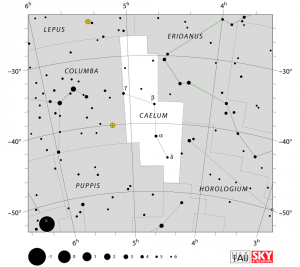By Dave Blane
Caelum is the Latin word for “the chisel,” and was created by the French astronomer Nicolas Louis de Lacaille in the 18th century. This small, faint constellation was originally named Caela Sculptoris, the sculptor’s chisel.
Gamma Caeli is an interesting multiple star system in the Caelum constellation. It actually consists of two star systems. The brighter one, gamma-1 Caeli is a binary star with an orange giant for a primary component and a fainter star as the companion. Gamma-2 Caeli, another double star system, consists of a yellow-white giant and also a fainter companion star.
The system may be found five degrees following epsilon Col and is a wide (13 arc min) pair of stars which make up an easy binocular double and may just be visible to the naked eye. This is gamma1 (V = 4.7) and gamma2 Caeli (V = 6.3). There is much more here for the telescopic observer to note, because both these stars are again double. Gamma1 (05 04 24.40 -35 28 58.7) somehow missed the attention of John Herschel and was swept up by Captain Jacob in 1847. The companion at magnitude 8.2 is currently 3″.2 distant in position angle 305 degrees. There is slow retrograde motion and the distance is gradually increasing. The primary is a K3 giant and indeed Hartung notes the colour to be orange, with the companion white. Gamma2 was discovered to be a close unequal pair by the Hipparcos satellite and is now called HDS658. The companion (mag 9.7) is 0″.9 away in position angle 195 degrees – there has been about 12 degrees of motion since discovery. This star should be visible in 30-cm on a good night. Both gamma1 and gamma2 are in Hipparcos but gamma1 has a parallax of 17.90 mas whereas that of gamma2 is 10.15 mas.
(ref : Bob Argyle, Webb Deep Sky Society)


